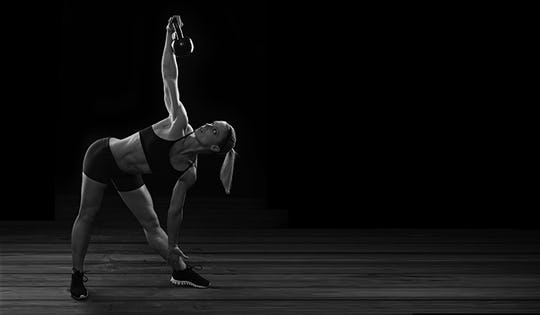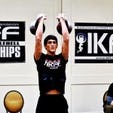When I think of training, I try to keep things simple. If you draw a line and have each end represent the opposite ends of the training spectrum, you’d have “Strength” on one end and “Endurance” on the other. You could probably think of a few sports that fall under these two absolutes. Olympic lifting, shot putting, and short sprinting require all-out strength, whereas marathon running and triathlon events require minimal power and more endurance.
Strength Circuits for Power Athletes
If we take that same line and connect the ends, drawing a curved semi-circle, you will have the middle representing a balance between strength and conditioning. Most athletes are going to require moments of strength and power along with the endurance to replicate the strength and power repeatedly.
Sports like soccer, basketball, martial arts, and wrestling fall somewhere in the middle. Soldiers also need to have that balance between strength and endurance to be completely combat ready for the rigors on the battlefield. Even civilians are more stop-and-go; to quote my friend Jason Dolby of the Orange Kettlebell Club; “Life is in the middle.”
Depending on the sports you play or the activities you do, the energy system required to sustain that activity is different. The strength and power athlete, like the sprinter, is considered anerobic; requiring ATP and/or creatine phosphate for energy to sustain the activity anywhere from 1-20 seconds.
Strength Circuits for Endurance Athletes
The endurance athlete, like the triathlete, utilizes a completely different energy system and requires muscle, glycogen, and fat to sustain their activity anywhere from 2 minutes on the low end to hours of activity.
Those “middle of the road” sports that are a combination of strength, power, and endurance like soccer and wrestling require energy to sustain activity anywhere from 20 seconds to 2 minutes.
At the low duration of activity, ATP, creatine phosphate, and glycogen are used to sustain activity. As the activity continues closer to the 40 second mark, lactate acid begins to build and the body begins to produce lactic acid.
Training should reflect the type of sport or activity you want to perform your best at. If you are a high school wrestler, running for an hour three times a week might not be the best for a sport that requires you to perform repeated bursts of speed and power; likewise, a daily strength training session of power cleans is not going to help the marathon runner.
For this reason, every person who comes into my gym to train (from athletes, police, firefighters, military professionals, and active adults) run through a strength circuit that reflects the type of activity they participate in at least once a week.
One of the best ways to develop an energy building training system is to incorporate circuits of various intervals using both bodyweight exercises and various strength tools including kettlebells, sandbags, ropes, and sleds.
When creating and customizing strength circuits, there are a few concepts to consider when incorporating them into your overall program:
Concepts of Custom Strength Circuits
- Make sure mobility, corrective exercises, and general strength work comes first
- Circuit exercises should be multi-joint movements which replicate athletic movements like squats, push ups, and pull ups.
- Circuit times should be around a 2:1 work to rest ratio. I prefer 20-60 seconds of work and 10-30 seconds of rest.
- Each exercise should fit your needs and be safe to perform at a continuous and fast rate.
- The exercise selection should be balanced and organized properly; for instance, pushing and pulling movements should be grouped, as well as single sided movements (lunges, step ups, rows and 1-arm push ups).
- Ideally, exercise stations should alternate so that the same primary muscle groups are not used consecutively. For example, I like to follow bar inverted rows with a lower body movement to allow the upper body time to recover.
Here are some examples of various strength and conditioning circuits I use to get my athletes in shape and performing at their best.
Body Weight Only Circuit
| No equipment needed, only a strong will to survive. Three rounds of three exercises consisting of squats, push ups, and planks for various timed intervals. There is no rest between exercises, but there is a 30-60 second rest between each round. This circuit can be performed 2 to 3 times. The planks can either be done in a traditional manner using your forearms or to make it more challenging, stay in the push up position. |
|
Round |
Exercise 1 |
Exercise 2 |
Exercise 3 |
Time |
|
1 |
Push Up |
Plank |
15 Sec |
|
|
2 |
Squat |
Push Up |
Plank |
20 Sec |
|
3 |
Squat |
Push Up |
Plank |
30 Sec |
Kettlebell Circuit
| This circuit consists of four rounds of three exercises; round one and three utilize both arms and legs while round two and four are single-sided, therefore requiring you to do both sides before moving to the next round. Choose a kettlebell you can use for every exercise knowing that some movements may be easier or harder to perform than others. Each exercise is performed for 30 seconds of work and 15 seconds of rest. Complete all four rounds before rest- ing 1-3 minutes or starting another circuit. Perform this whole circuit 2-3 times. |
|
Round |
Exercise 1 |
Exercise 2 |
Exercise 3 |
Time |
|
1 |
Goblet Squat |
2-Arm Push Press |
2-Arm Swing |
30 Sec |
|
2 |
1-Arm Squat |
1-Arm Push Press |
1-Arm Swing |
30 Sec |
|
3 |
Alt. Goblet Lunges |
Kettlebell Push Ups |
Alt. Arm Swing |
30 Sec |
|
4 |
Single Leg RDL |
1- Arm Rows |
1-Arm Snatch |
30 Sec |
Unilateral Circuit
| One of my favorite types of circuits is to work unilaterally to try and balance out the sides as much as possible. In this circuit you will perform the movement on one side for 30-45 seconds, rest 15-20 seconds and repeat on the other side then move to the next station. Exercise selection is up to you. |
|
Exercise |
Work Interval |
Rest Interval |
|
Sandbag Shoulder |
45 Sec |
20 Sec |
|
Single Dumbbell |
45 Sec |
20 Sec |
|
1-Side Kettlebell |
45 Sec |
20 Sec |
|
Singel Overhead |
45 Sec |
20 Sec |
|
Tire Sledgehammer |
45 Sec |
20 Sec |
Outdoor Circuit
|
This workout is one of my favorite circuits because it is a nice combination of bodyweight and unconventional exercises utilizing many different planes of motion. My athletes like it because it can be done outside; which seems to help offset the pain on a beautiful day. I like to perform this circuit using pull ups, tire flips, [water-filled] keg presses, double racked kettlebell farmer walks, battle ropes and push-ups on cinder blocks. If you don’t have the same equipment, feel free to make substitutions or adjustments. Sometimes we use a sandbag press instead of the keg or perform a tire farmer walk instead of using kettlebells; the possibilities are endless. I like to have my athletes go for 45 seconds of work and 20 seconds of rest for three rounds resting about 2-3 minutes between each round. |
|
Exercise |
Work Interval |
Rest Interval |
|
Pull Ups |
45 Sec |
20 Sec |
|
Tire Flip |
45 Sec |
20 Sec |
|
Keg Press |
45 Sec |
20 Sec |
|
Racked Kettlebell |
45 Sec |
20 Sec |
|
Battle Ropes |
45 Sec |
20 Sec |
|
Cinder Block Push Ups |
45 Sec |
20 Sec |

)





